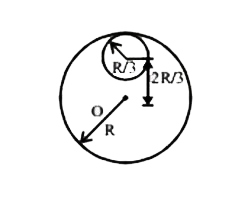The radius of gyration of a uniform disc of radius R, about an axis passing through a point away from the centre of disc, and perpendicular to the plane of disc is:
The correct Answer is:C
To find the radius of gyration of a uniform disc of radius R about an axis passing through a point R2 away from the center of the disc and perpendicular to the plane of the disc, we can follow these steps:
Step 1: Understand the Problem
We need to calculate the radius of gyration k of a uniform disc about a specific axis (CD) that is located at a distance of R2 from the center of the disc.
Step 2: Identify the Moment of Inertia
The moment of inertia I of a uniform disc about its central axis (AB) is given by:
IAB=12mR2
where m is the mass of the disc and R is the radius of the disc.
Step 3: Apply the Parallel Axis Theorem
To find the moment of inertia about the axis CD, we use the parallel axis theorem, which states:
ICD=IAB+md2
where d is the distance between the two axes. Here, d=R2.
Step 4: Calculate the Moment of Inertia about Axis CD
Substituting the values into the equation:
ICD=12mR2+m(R2)2
Calculating m(R2)2:
m(R2)2=mR24
Now substituting this back into the equation for ICD:
ICD=12mR2+mR24=24mR2+14mR2=34mR2
Step 5: Calculate the Radius of Gyration
The radius of gyration k is defined as:
k=√ICDm
Substituting ICD into this formula:
k=√34mR2m=√34R2=√34R=√32R
Final Answer
Thus, the radius of gyration of the uniform disc about the specified axis is:
k=√32R
We need to calculate the radius of gyration k of a uniform disc about a specific axis (CD) that is located at a distance of R2 from the center of the disc.
The moment of inertia I of a uniform disc about its central axis (AB) is given by:
IAB=12mR2
where m is the mass of the disc and R is the radius of the disc.
To find the moment of inertia about the axis CD, we use the parallel axis theorem, which states:
ICD=IAB+md2
where d is the distance between the two axes. Here, d=R2.
Substituting the values into the equation:
ICD=12mR2+m(R2)2
Calculating m(R2)2:
m(R2)2=mR24
Now substituting this back into the equation for ICD:
ICD=12mR2+mR24=24mR2+14mR2=34mR2
The radius of gyration k is defined as:
k=√ICDm
Substituting ICD into this formula:
k=√34mR2m=√34R2=√34R=√32R
Thus, the radius of gyration of the uniform disc about the specified axis is:
k=√32R
Topper's Solved these Questions
- JEE MAIN REVISION TEST- 24 BOOK - VMC MODULES ENGLISHCHAPTER - JEE MAIN REVISION TEST- 24 EXERCISE - PHYSICS ( SECTION - 2)
5 Videos
- JEE MAIN REVISION TEST- 16BOOK - VMC MODULES ENGLISHCHAPTER - JEE MAIN REVISION TEST- 16EXERCISE - PHYSICS (SECTION 2)
5 Videos
- JEE Main Revision Test-20 | JEE-2020 BOOK - VMC MODULES ENGLISHCHAPTER - JEE Main Revision Test-20 | JEE-2020 EXERCISE - PHYSICS
25 Videos
Similar Questions
The radius of gyration of a uniform solid sphere of radius R., about an axis passing through a point R2 away from the centre of the sphere is:
View SolutionThe radius of gyration of a uniform rod of length l , about an axis passing through a point l8away form the centre of the rod , and perpendicular to it is:
View SolutionThe radius of gyration of a uniform rod of length l , about an axis passing through a point l8away form the centre of the rod , and perpendicular to it is:
View SolutionRadius of gyration of a uniform circular disc about an axis passing through its centre of gravity and perpendicular to its plane is
View SolutionThe ratio of radii of gyration of a circular ring and a circular disc, of the same mass and radius about an axis passing through their centres and perpendicular to their planes are
View SolutionMoment of inertia of a uniform quarter disc of radius R and mass M about an axis through its centre of mass and perpendicular to its plane is :
View SolutionMoment of inertia of a uniform quarter disc of radius R and mass M about an axis through its centre of mass and perpendicular to its plane is :
View SolutionIf a circular concentric hole is made on a disc then about an axis passing through the centre of the disc and perpendicular to its plane
View SolutionA disc has mass 9 m. A hole of radius R/3 is cut from it as shown in the figure. The moment of inertia of remaining part about an axis passing through the centre 'O' of the disc and perpendicular to the plane of the disc is :

View SolutionA uniform brass disc of radius a and mass m is set into spinning with angular speed ω0 about an axis passing through centre of disc and perpendicular to the palne of disc. If its temperature increases from θ∘1C to θ∘2C with out disturbing the disc, what will be its new angular speed ?
View Solution
